Jung-Eun Kim
Explaining How Quantization Disparately Skews a Model
Sep 08, 2025Abstract:Post Training Quantization (PTQ) is widely adopted due to its high compression capacity and speed with minimal impact on accuracy. However, we observed that disparate impacts are exacerbated by quantization, especially for minority groups. Our analysis explains that in the course of quantization there is a chain of factors attributed to a disparate impact across groups during forward and backward passes. We explore how the changes in weights and activations induced by quantization cause cascaded impacts in the network, resulting in logits with lower variance, increased loss, and compromised group accuracies. We extend our study to verify the influence of these impacts on group gradient norms and eigenvalues of the Hessian matrix, providing insights into the state of the network from an optimization point of view. To mitigate these effects, we propose integrating mixed precision Quantization Aware Training (QAT) with dataset sampling methods and weighted loss functions, therefore providing fair deployment of quantized neural networks.
RESQUE: Quantifying Estimator to Task and Distribution Shift for Sustainable Model Reusability
Dec 20, 2024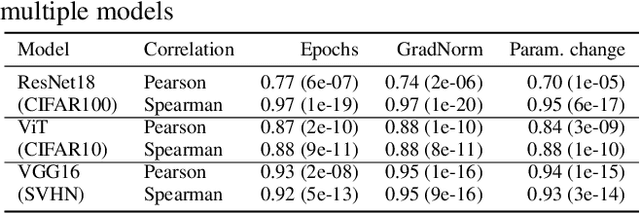

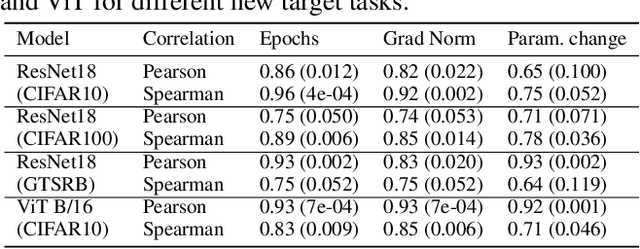
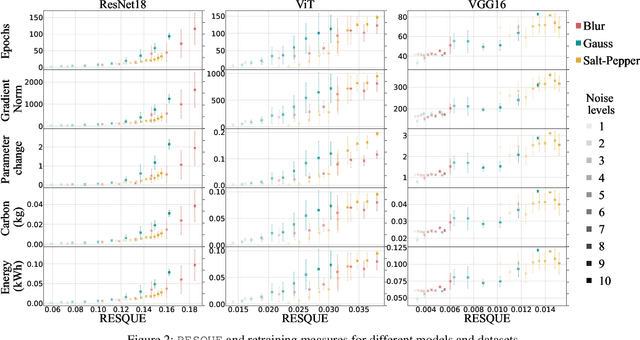
Abstract:As a strategy for sustainability of deep learning, reusing an existing model by retraining it rather than training a new model from scratch is critical. In this paper, we propose REpresentation Shift QUantifying Estimator (RESQUE), a predictive quantifier to estimate the retraining cost of a model to distributional shifts or change of tasks. It provides a single concise index for an estimate of resources required for retraining the model. Through extensive experiments, we show that RESQUE has a strong correlation with various retraining measures. Our results validate that RESQUE is an effective indicator in terms of epochs, gradient norms, changes of parameter magnitude, energy, and carbon emissions. These measures align well with RESQUE for new tasks, multiple noise types, and varying noise intensities. As a result, RESQUE enables users to make informed decisions for retraining to different tasks/distribution shifts and determine the most cost-effective and sustainable option, allowing for the reuse of a model with a much smaller footprint in the environment. The code for this work is available here: https://github.com/JEKimLab/AAAI2025RESQUE
Superficial Safety Alignment Hypothesis
Oct 07, 2024Abstract:As large language models (LLMs) are overwhelmingly more and more integrated into various applications, ensuring they generate safe and aligned responses is a pressing need. Previous research on alignment has largely focused on general instruction-following but has often overlooked the unique properties and challenges of safety alignment, such as the brittleness of safety mechanisms. To bridge the gap, we propose the Superficial Safety Alignment Hypothesis (SSAH), which posits that safety alignment should teach an otherwise unsafe model to choose the correct reasoning direction - interpreted as a specialized binary classification task - and incorporate a refusal mechanism with multiple reserved fallback options. Furthermore, through SSAH, we hypothesize that safety guardrails in LLMs can be established by just a small number of essential components. To verify this, we conduct an ablation study and successfully identify four types of attribute-critical components in safety-aligned LLMs: Exclusive Safety Unit (ESU), Exclusive Utility Unit (EUU), Complex Unit (CU), and Redundant Unit (RU). Our findings show that freezing certain safety-critical components 7.5\% during fine-tuning allows the model to retain its safety attributes while adapting to new tasks. Additionally, we show that leveraging redundant units 20\% in the pre-trained model as an ``alignment budget'' can effectively minimize the alignment tax while achieving the alignment goal. All considered, this paper concludes that the atomic functional unit for safety in LLMs is at the neuron level and underscores that safety alignment should not be complicated. We believe this work contributes to the foundation of efficient and scalable safety alignment for future LLMs.
Estimating Environmental Cost Throughout Model's Adaptive Life Cycle
Jul 23, 2024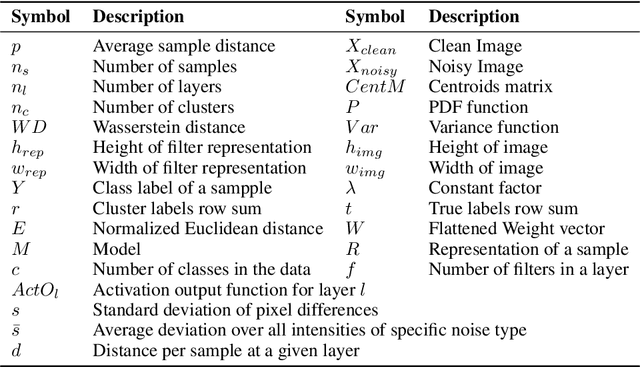


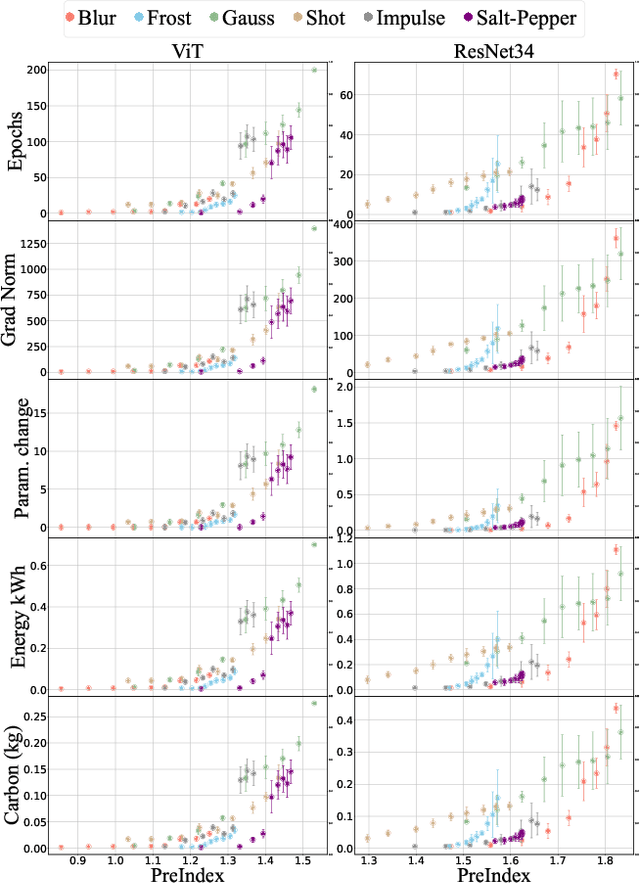
Abstract:With the rapid increase in the research, development, and application of neural networks in the current era, there is a proportional increase in the energy needed to train and use models. Crucially, this is accompanied by the increase in carbon emissions into the environment. A sustainable and socially beneficial approach to reducing the carbon footprint and rising energy demands associated with the modern age of AI/deep learning is the adaptive and continuous reuse of models with regard to changes in the environment of model deployment or variations/changes in the input data. In this paper, we propose PreIndex, a predictive index to estimate the environmental and compute resources associated with model retraining to distributional shifts in data. PreIndex can be used to estimate environmental costs such as carbon emissions and energy usage when retraining from current data distribution to new data distribution. It also correlates with and can be used to estimate other resource indicators associated with deep learning, such as epochs, gradient norm, and magnitude of model parameter change. PreIndex requires only one forward pass of the data, following which it provides a single concise value to estimate resources associated with retraining to the new distribution shifted data. We show that PreIndex can be reliably used across various datasets, model architectures, different types, and intensities of distribution shifts. Thus, PreIndex enables users to make informed decisions for retraining to different distribution shifts and determine the most cost-effective and sustainable option, allowing for the reuse of a model with a much smaller footprint in the environment. The code for this work is available here: https://github.com/JEKimLab/AIES2024PreIndex
Representation Magnitude has a Liability to Privacy Vulnerability
Jul 23, 2024Abstract:The privacy-preserving approaches to machine learning (ML) models have made substantial progress in recent years. However, it is still opaque in which circumstances and conditions the model becomes privacy-vulnerable, leading to a challenge for ML models to maintain both performance and privacy. In this paper, we first explore the disparity between member and non-member data in the representation of models under common training frameworks. We identify how the representation magnitude disparity correlates with privacy vulnerability and address how this correlation impacts privacy vulnerability. Based on the observations, we propose Saturn Ring Classifier Module (SRCM), a plug-in model-level solution to mitigate membership privacy leakage. Through a confined yet effective representation space, our approach ameliorates models' privacy vulnerability while maintaining generalizability. The code of this work can be found here: \url{https://github.com/JEKimLab/AIES2024_SRCM}
Aggregate Representation Measure for Predictive Model Reusability
May 15, 2024



Abstract:In this paper, we propose a predictive quantifier to estimate the retraining cost of a trained model in distribution shifts. The proposed Aggregated Representation Measure (ARM) quantifies the change in the model's representation from the old to new data distribution. It provides, before actually retraining the model, a single concise index of resources - epochs, energy, and carbon emissions - required for the retraining. This enables reuse of a model with a much lower cost than training a new model from scratch. The experimental results indicate that ARM reasonably predicts retraining costs for varying noise intensities and enables comparisons among multiple model architectures to determine the most cost-effective and sustainable option.
Center-Based Relaxed Learning Against Membership Inference Attacks
Apr 26, 2024Abstract:Membership inference attacks (MIAs) are currently considered one of the main privacy attack strategies, and their defense mechanisms have also been extensively explored. However, there is still a gap between the existing defense approaches and ideal models in performance and deployment costs. In particular, we observed that the privacy vulnerability of the model is closely correlated with the gap between the model's data-memorizing ability and generalization ability. To address this, we propose a new architecture-agnostic training paradigm called center-based relaxed learning (CRL), which is adaptive to any classification model and provides privacy preservation by sacrificing a minimal or no loss of model generalizability. We emphasize that CRL can better maintain the model's consistency between member and non-member data. Through extensive experiments on standard classification datasets, we empirically show that this approach exhibits comparable performance without requiring additional model capacity or data costs.
The Over-Certainty Phenomenon in Modern UDA Algorithms
Apr 24, 2024Abstract:When neural networks are confronted with unfamiliar data that deviate from their training set, this signifies a domain shift. While these networks output predictions on their inputs, they typically fail to account for their level of familiarity with these novel observations. This challenge becomes even more pronounced in resource-constrained settings, such as embedded systems or edge devices. To address such challenges, we aim to recalibrate a neural network's decision boundaries in relation to its cognizance of the data it observes, introducing an approach we coin as certainty distillation. While prevailing works navigate unsupervised domain adaptation (UDA) with the goal of curtailing model entropy, they unintentionally birth models that grapple with calibration inaccuracies - a dilemma we term the over-certainty phenomenon. In this paper, we probe the drawbacks of this traditional learning model. As a solution to the issue, we propose a UDA algorithm that not only augments accuracy but also assures model calibration, all while maintaining suitability for environments with limited computational resources.
ReffAKD: Resource-efficient Autoencoder-based Knowledge Distillation
Apr 15, 2024Abstract:In this research, we propose an innovative method to boost Knowledge Distillation efficiency without the need for resource-heavy teacher models. Knowledge Distillation trains a smaller ``student'' model with guidance from a larger ``teacher'' model, which is computationally costly. However, the main benefit comes from the soft labels provided by the teacher, helping the student grasp nuanced class similarities. In our work, we propose an efficient method for generating these soft labels, thereby eliminating the need for a large teacher model. We employ a compact autoencoder to extract essential features and calculate similarity scores between different classes. Afterward, we apply the softmax function to these similarity scores to obtain a soft probability vector. This vector serves as valuable guidance during the training of the student model. Our extensive experiments on various datasets, including CIFAR-100, Tiny Imagenet, and Fashion MNIST, demonstrate the superior resource efficiency of our approach compared to traditional knowledge distillation methods that rely on large teacher models. Importantly, our approach consistently achieves similar or even superior performance in terms of model accuracy. We also perform a comparative study with various techniques recently developed for knowledge distillation showing our approach achieves competitive performance with using significantly less resources. We also show that our approach can be easily added to any logit based knowledge distillation method. This research contributes to making knowledge distillation more accessible and cost-effective for practical applications, making it a promising avenue for improving the efficiency of model training. The code for this work is available at, https://github.com/JEKimLab/ReffAKD.
Cooperative Learning for Cost-Adaptive Inference
Dec 26, 2023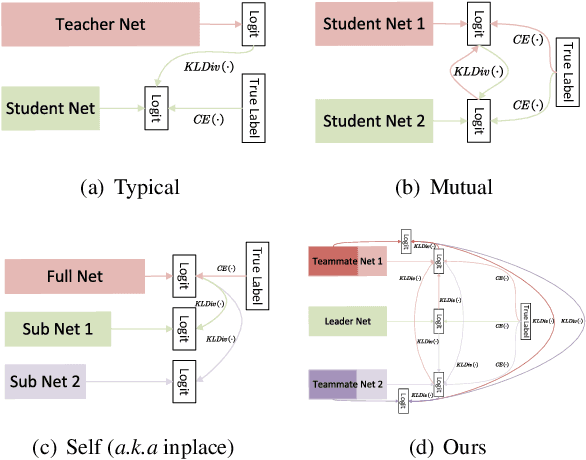
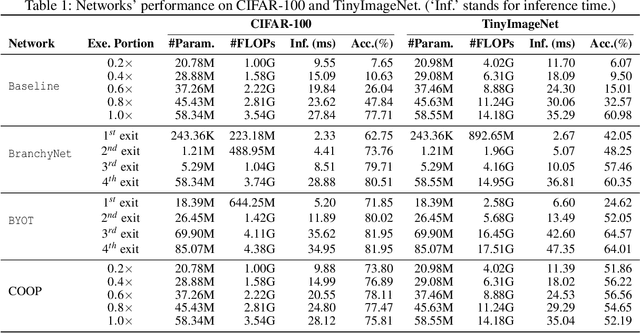
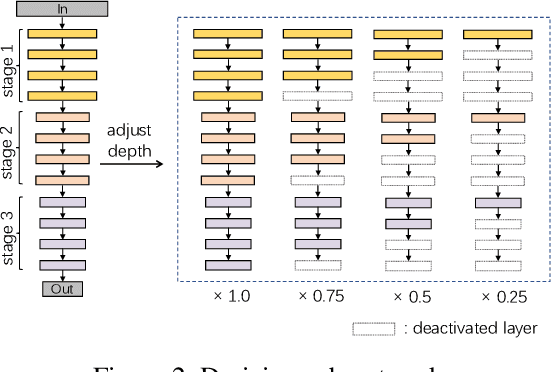
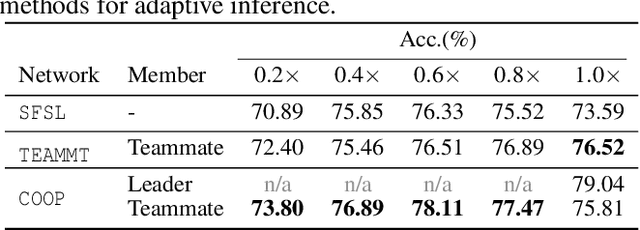
Abstract:We propose a cooperative training framework for deep neural network architectures that enables the runtime network depths to change to satisfy dynamic computing resource requirements. In our framework, the number of layers participating in computation can be chosen dynamically to meet performance-cost trade-offs at inference runtime. Our method trains two Teammate nets and a Leader net, and two sets of Teammate sub-networks with various depths through knowledge distillation. The Teammate nets derive sub-networks and transfer knowledge to them, and to each other, while the Leader net guides Teammate nets to ensure accuracy. The approach trains the framework atomically at once instead of individually training various sizes of models; in a sense, the various-sized networks are all trained at once, in a "package deal." The proposed framework is not tied to any specific architecture but can incorporate any existing models/architectures, therefore it can maintain stable results and is insensitive to the size of a dataset's feature map. Compared with other related approaches, it provides comparable accuracy to its full network while various sizes of models are available.
 Add to Chrome
Add to Chrome Add to Firefox
Add to Firefox Add to Edge
Add to Edge